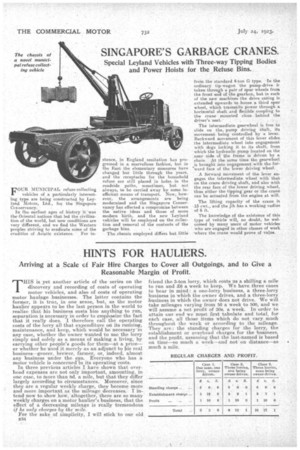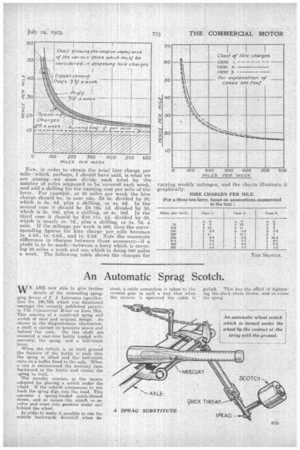HINTS FOR HAULIERS.
Page 20

Page 21

If you've noticed an error in this article please click here to report it so we can fix it.
Arriving at a Scale of Fair Hire Charges to Cover all Outgoings, and to Give a Reasonable Margin of Profit.
THI § is yet another article of the series on the discovery and recording of costs of operating motor vehicles, and also of costs of operating motor haulage businesses. The latter contains the former, it is true, in one sense, but, as the motor haulier appears to be the last person in the world to realize that his business costs him anything to run, separation is necessary in order to emphasize the fact that it really does. I therefore call the operating costs of the lorry all that expenditure on its runiiing, maintenance, and keep, which would be necessary 'in any case, whether the owner wanted to use the lorry simply and solely as a means of making a living, by carrying other people's goods for them—at a price-or Whether he used it merely as an adjunct to his real business—grocer, brewer, farmer, or, indeed, almost any business under the sun. Everyone who has a motor vehicle is concerned in its operating costs.
In three previous articles I have shown that overhead expenses are not only important, amounting, in one case, to inore than Ed. a mile, but that they differ largely according to circumstances. Moreover, since they are a regular weekly charge, they become more , and more important as the mileage decreases. I in
tend now to show how, altogether, there are so many weekly charges on a motor haulier's business, that the effect of a decreasing mileage is really tremendous if he only charges-by the mile.
For the sake of simplicity, I will stick to our old B34
friend the 3-ton lorry, which costs us a shilling a mile to run and £6 a week to keep. We have three cases to bear in mind : a one-lorry business, a three-lorry business in which the owner drives, and a three-lorry business in which the owner does not drive. We will take mileages varying from 50 a week to 500, and we will assume a net profit of 30s. a week. In order to attain our end we must first tabulate and total, for each case, all those items which do not vary much throughout the week or according to the mileage. They are : the standing charges for the lorry, the establishment or overhead charges for the business, and the profit, assuming that the last-named is based on time—so much a week—and not on distance—so much a mile.
Now, in order to obtain the total hire charge per mile—which; perhaps, I should have said, is what we are aiming—we must. divide each total by the number of miles supposed to be covered each week, and add a shilling for the running cost per mile of the lorry. • For example, at 50 miles per week the hire charge should be, in case one, .t9 3s. divided by 50,which is 3s. 8d plus a shilling, or 45. Bd. In the
Second case it should be 12s: Id. divided by 50, which is as. 10d. plus •zi shilling, or 45. 10d. In the third case it should be £10 17s. 1.d. divided by 50, which is nearly 4s. 7d., plus a shilling, or 5s. Id. a mile. If the mileage per week is 500, then the corresponding figures for hire charge per, mile becomes Is. 4.4d., is. 4.6d., and is. 5.2d. Note the enormous difference in charges between those necessary—if a vtofit is to be made--between a lorry which is covering 50 Miles a week and one which is doing 500 miles a week. The following table shows the charges for
































